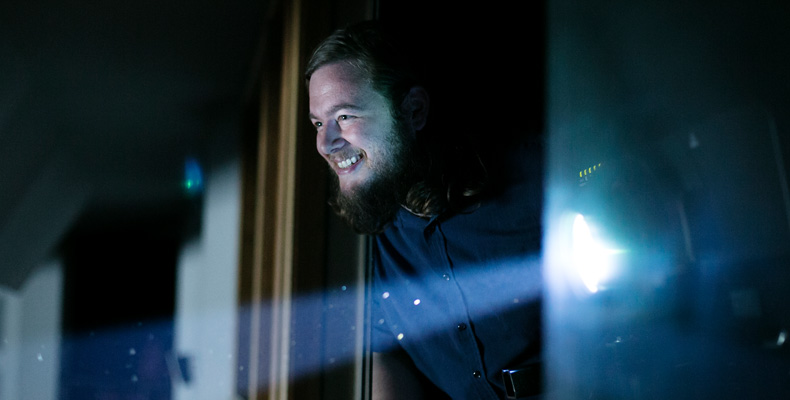Max Tohline came to Missouri S&T from Madeira, Ohio, in 2002 with a plan to study aerospace engineering. But it was an elective course in film that caused his true passion to take flight.
“I always had an interest in film,” says Tohline. So he enrolled in Study of Film, a course taught at that time by James Bogan, Curators’ Teaching Professor emeritus of art history and film.
“Jim took this little spark of interest in film and turned it into a projector beam on full blast,” Tohline says.
It began during the first day of class. “He asked us what our favorite movie was,” Tohline recalls, “and someone said The Graduate. And I scoffed.” Bogan heard it and, according to Tohline, replied, “I hope that was a scoff for everybody who hasn’t seen the movie.”
Bogan’s playful rebuke led Tohline to watch the movie again. That second screening gave Tohline a new perspective on the film.
These days, Tohline is trying to help current students take a different perspective on life by having them watch and analyze movies. After graduating from S&T in 2007 with a B.A. in English, he went to Ohio University to pursue a master’s degree in film studies and a Ph.D. in interdisciplinary arts. (The Ph.D. is still a work in progress.) He returned to Missouri S&T three years ago as a lecturer in arts, languages and philosophy to teach the same course Bogan taught him – and countless other students for more than four decades. As part of that course, Tohline is also responsible for leading the popular Tuesday night free film series, which is also open to the public.
The course attracts a wide array of majors, as it did during Tohline’s student days. Students may enroll because of their fondness for film, but there’s more to the course than weekly movies. Tohline uses the issues raised by the films he shows as entrées into serious philosophical discussions.
“In many disciplines, we are learning how to find the answers to questions that have been around for a long time,” Tohline says. “The right answer is already known. It’s in the back of the book.
“But if we want our graduates to take the lead in the future,” he adds, “they’ll need to come up with questions that have never been asked. That’s how innovation happens. In this class, I want students to brainstorm questions that have never been asked before.”
That brainstorming happens at the end of each Tuesday night movie. After the credits roll, Tohline and the 50 or so students enrolled in his course hang around to discuss the questions posed by that evening’s flick.
“I like to think of it as a questions laboratory, where we ask, ‘How can I push myself to think a thought that I’ve never had before?’ Thought-provoking films are a great way to do that,” Tohline says.
The first film in this fall’s series is a prime example. Her, a 2013 comedy-drama produced and directed by Spike Jonze, centers on a man who falls in love with artificial intelligence. “It raises all sorts of questions about what it means to be human, what it means to fall in love, what our relationship with technology will be in the future,” Tohline says.
Later in the semester, Tohline will screen The Act of Killing, a 2012 documentary in which director Joshua Oppenheimer challenges death-squad leaders in Indonesia to re-enact the mass killings they committed in the 1960s in any cinematic genre they wish. “This film really causes you to think about the limits of human experience,” Tohline says. “What are people capable of justifying to themselves? What will the human mind accept?”
Through Study of Film and other courses, Tohline hopes to also help Missouri S&T students develop media literacy – a skill that is greatly needed in today’s media-saturated society, he says.
In one class exercise, he shows students the opening 3 minutes from the movie The Dark Knight. “We turn the sound off,” he says, “and I have everyone in the class say ‘cut’ whenever they see an edit.”
Through that exercise, students learn to think more critically about how editing can create certain impressions on an audience.
“If you’ve never noticed editing before, you now become aware of how ubiquitous it is,” Tohline says, “and once we notice the sheer mass of it, we can start asking ourselves, ‘Oh, wait. So what is this doing? How is this creating my impression of things?’”
When he isn’t analyzing and discussing film, Tohline is finishing his Ph.D. dissertation on the use of reverse motion, “when time runs backwards in movies.” Once that dissertation is completed, he plans to devote himself fully to Missouri S&T’s film studies.
“They hired me to be the next Jim Bogan, and I want to be here for as long as he was.”
* * *
Keep up with Tohline’s film class on Twitter (follow @SandTFilm) and Facebook.
Check out Tohline’s video analysis of editing in the classic Spaghetti Western, The Good, The Bad and The Ugly.

Great article about great work! Keep the questions going!